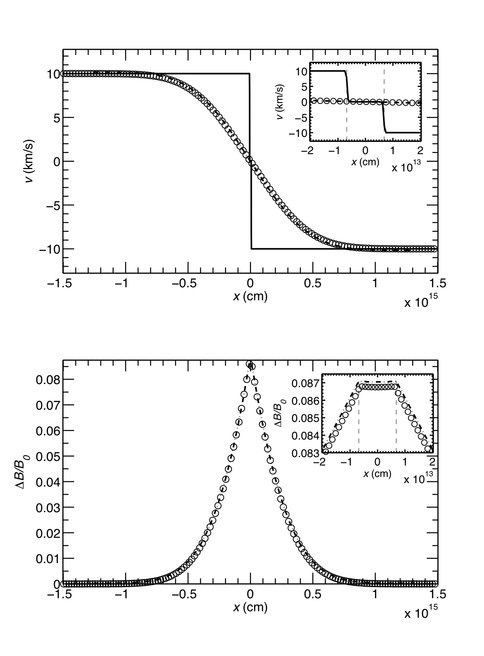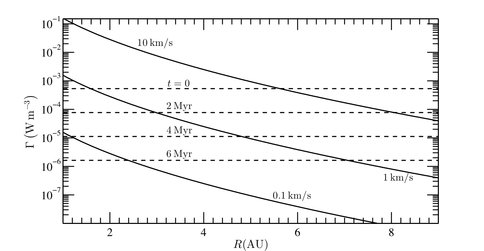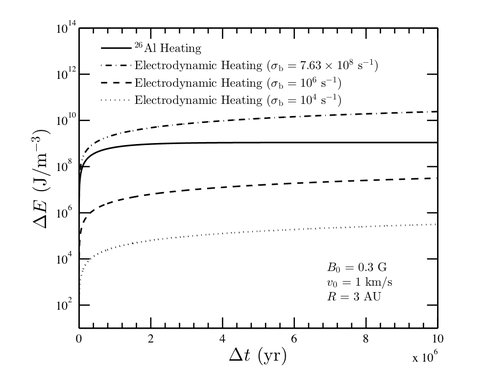2013 Annual Science Report
 Rensselaer Polytechnic Institute
Reporting | SEP 2012 – AUG 2013
Rensselaer Polytechnic Institute
Reporting | SEP 2012 – AUG 2013
Project 2: Processing of Precometary Ices in the Early Solar System
Project Summary
The discovery of numerous planetary systems still in the process of formation provides a unique opportunity to see how our own solar system may have formed 4.6 billion years ago. Our research group studies physical processes that determine thermal environments in and around young planetary systems in order to constrain the prebiotic chemistry which can occur there. In one study we have built a unique code which simulates the heating of dense molecular gas in chemically active outflows (CAOs) associated with protostars. Our code will be used to model the wealth of molecular observations of CAOs which will be obtained by SOFIA and other observatories. In another study we have discovered a new mechanism whereby asteroids in the solar nebula are heated by magnetohydrodynamical processes. The goal of the second study is to determine whether asteroids can be warm enough to support prebiotic chemistry in protoplanetary systems that were not innoculated by short-lived radionuclides such as aluminum-26.
Project Progress
A. Molecular Line Emission from Multifluid, Magnetohydodynamic Shock Waves
A.1 Background
The goal of this project is to simulate molecular line emission from shock waves, including shocks produced by protostellar outflows as well as shocks associated with colliding clouds and interacting supernova remnants. We aim to provide tools which can be used to interpret the wealth of molecular line observations of prebiotic molecules to be expected over the next several years from SOFIA, ALMA, and other infrared and radio observatories. For example, the SOFIA Cycle 1 observing program includes observations of molecular line emission using the GREAT spectrometer (PI J. Hewitt, NASA Goddard). Realistic simulations of shock-excited molecular line emission from weakly-ionized plasmas require time-dependent, magnetohydodynamic calculations, which treat the plasma as three interacting fluids (the neutral gas, ion/electron plasma, and charged dust grains). There is no active research group in the US, to our knowledge, with the capacity to carry out such calculations.
A.2 Progress Report
Ciolek and Roberge published a paper (Ciolek & Roberge 2013) on numerical methods for simulating time-dependent, mutlifluid shock waves. Their algorithm uses operator splitting, a finite difference scheme based on Godunov’s method for gas dynamics, plus TVD (total variation diminishing) techniques. It allows for mass, momentum, and energy exchange between different fluids by ion-electron recombination, elastic ion-neutral scattering, and other atomic and molecular processes. Ciolek & Roberge give an extensive set of benchmark tests which establish the accuracy and robustness of their algorithm, and demonstrate how its accuracy scales with the resolution of their finite difference mesh. Grad student Raymond Menzel has spent most of 2013 on further development of the multifluid shock code. His task has been to implement the atomic and molecular physics required to model radiative cooling and diagnostic emission lines.
While including line emission has greatly enhanced the realism of our shock simulations, it also has also increased our computational requirements enormously. The problem is basically that (i) one must use tens of thousands of mesh points to model shocks, which have spatial structure on length scales spanning several orders of magnitude; and (ii) one must simultaneously calculate the populations of >100 excited states of H2 and CO at each mesh point. To address this problem, Roberge initiated a collaboration with an applied mathematician, Prof. Pablo Suarez from Delaware State University (DSU). Suarez was awarded an NAI-sponsored Minority Institution Research Support (MIRS) fellowship to collaborate with Roberge’s group on adaptive mesh refinement (AMR) techniques for the shock code. AMR has the potential to greatly enhance computational efficiency, by putting mesh points only where needed (e.g., close to shock fronts). Suarez spent 10 weeks at NYCA during summer, 2013 working on AMR schemes for simple analogs of shock waves. Since then he has recruited two DSU students into the project. NYCA will fund Suarez and two students to visit NYCA again during summer, 2014.
We are undertaking a critical examination of a “pseudo-time dependent” (PTD) technique proposed by others for modeling multifluid shocks. The PTD method attempts to model time dependent shocks by “stitching together” the results obtained for different steady shocks.
The initial results of our work will be reported at the January, 2014 meeting of the American Astronomical Society (Menzel et al. 2014).
Ciolek, Roberge and Katz (2014) discovered a “quasi-self similar” (QSS) solution for the formation of multifluid shock waves in dusty plasmas. The new solution has two potentially important implications: (i) The QSS solution shows that the exact initial conditions for a shock simulation, which are impossible to know in practice, are actually not required because any initial state rapidly evolves into a QSS solution. (ii) It may be possible to vastly reduce the computational requirements for multifluid shock simulations. Much of this expense is associated with the need to include ion inertia at very early times. However the QSS solution describes a shock at times when ion inertia is no longer important throughout most of the shock.
Rensselaer undergraduate Jacob Leedom was supported by NYCA during summer, 2013 to work on grain destruction in multifluid shock waves. The abundance of SiO toward some protostellar shocks implies that grain destruction is occurring there. The potential implications for prebiotic chemistry are important because grain destruction makes phosphorous and other refractory elements available for gas phase chemistry. Leedom is working on grain destruction by a mechanism called betatron acceleration. Lyman Spitzer developed the theory of betatron acceleration for diffuse clouds; Leedom is extending Spitzer’s work to the dense plasmas around protostars.
B. Asteroid Thermal Environments
B.1 Background
The diverse inventory of amino acids and other organic molecules found in meteorites implies that asteroids once provided warm environments conducive to prebiotic chemistry. The goal of this project is to understand the physical mechanisms which heated asteroids and their prevalence in other protoplanetary disks.
B.2 Progress Report
Menzel and Roberge (2013) published a paper which reexamines a heating mechanism (“induction heating”) described in a classic series of papers by C.P. Sonett and collaborators. Classical induction postulates that the asteroids were swept by a powerful, fully-ionized T Tauri wind from the young Sun. Menzel and Roberge have revised this scenario to account for modern ideas about protoplanetary disks. Their principal results are (i) that classical induction theory is based on a subtle misunderstanding of the underlying physics; (ii) the correct physics predicts a new “electrodynamic heating” mechanism which is viable in weakly-ionized disks; (iii) for some flow geometries the rate of electrodynamic heating rate is zero; (iv) for other geometries electrodynamic heating can have a rate comparable to classical induction.
Grad student Allycia Gariepy was supported by NYCA during summer, 2013 to continue her work with Roberge on instabilities in multifluid shear flows around asteroids. These calculations are still in progress.
C. Collaborations with Other NYCA Investigators
Roberge continued to collaborate with NYCA team members (Baldwin, Watson, Delano, Swindle et al.) studying argon diffusion in lunar glasses. This project produced a recently submitted paper (Gombosi et al. 2013).
Roberge collaborated with NYCA co-investigator Bruce Watson and his colleague Daniele Cherniak on numerical and analytical models of diffusion in heated solids. Their work has produced an approximate analytical solution, the Gaussian approximation, which reproduces numerical simulations of diffusive loss for a variety of diffusion laws and temperature histories. These results were reported in a contributed paper by Watson et al. (2013) and a related refereed paper is in progress. Applications of these results, e.g., to diffusive losses caused by impact heating, are being explored.
Publications
-
Ciolek, G. E., & Roberge, W. G. (2013). MOLECULAR LINE EMISSION FROM MULTIFLUID SHOCK WAVES. I. NUMERICAL METHODS AND BENCHMARK TESTS. The Astrophysical Journal, 768(1), 78. doi:10.1088/0004-637x/768/1/78
-
Menzel, R. L., & Roberge, W. G. (2013). REEXAMINATION OF INDUCTION HEATING OF PRIMITIVE BODIES IN PROTOPLANETARY DISKS. The Astrophysical Journal, 776(2), 89. doi:10.1088/0004-637x/776/2/89
- Gombosi, D.J., Baldwin, S.L., Watson, E.B., Swindle, T.D., Delano, J.W. & Roberge, W.G. (2013). Argon Diffusion in Apollo 16 Impact Glass Spherules: Implications for 40Ar/39Ar Dating of Lunar Impact Events. Geochimicha et Cosmochimica Acta.
-
PROJECT INVESTIGATORS:
-
PROJECT MEMBERS:
Glenn Ciolek
Co-Investigator
Pablo Suarez
Co-Investigator
Allycia Gariepy
Collaborator
Max Katz
Collaborator
Raymond Menzel
Collaborator
-
RELATED OBJECTIVES:
Objective 1.1
Formation and evolution of habitable planets.
Objective 3.1
Sources of prebiotic materials and catalysts
Objective 3.2
Origins and evolution of functional biomolecules


